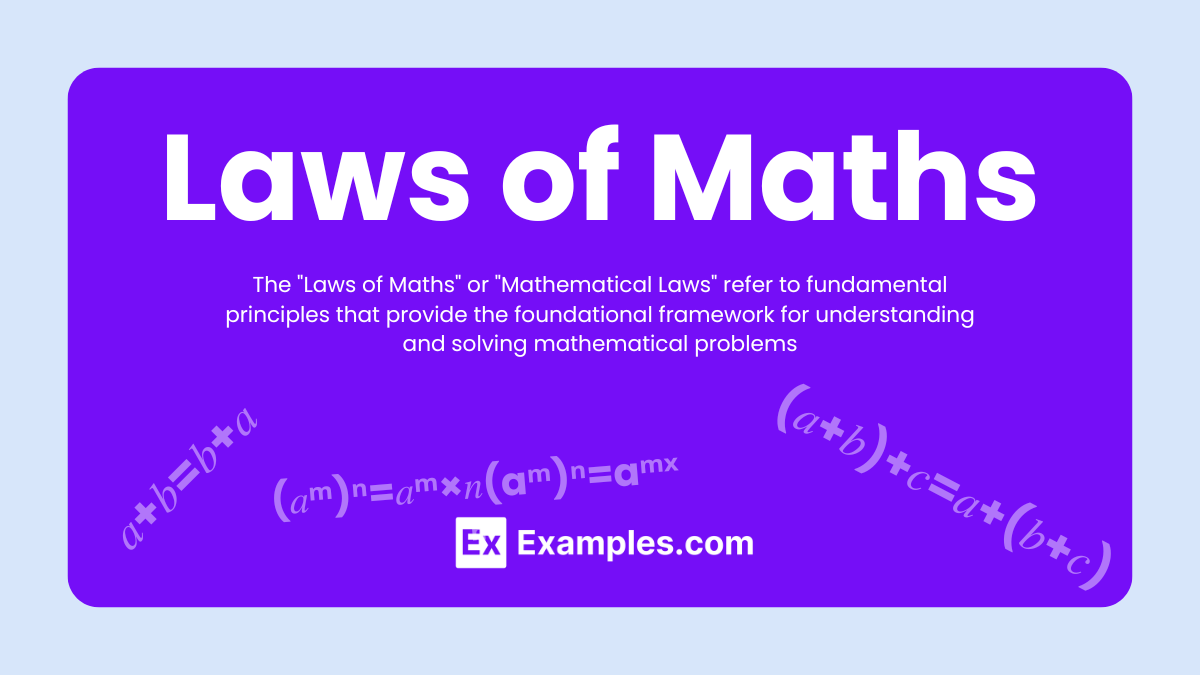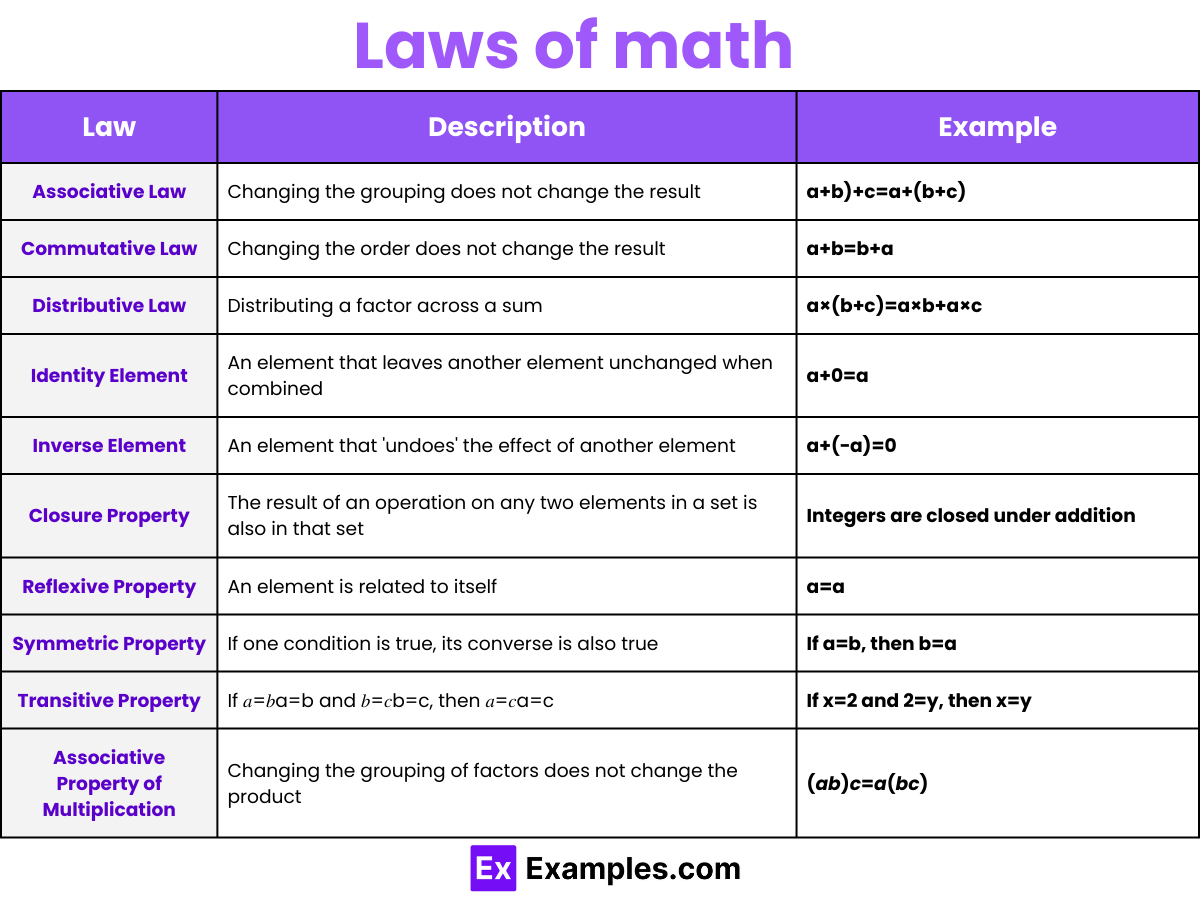Which of the following represents the distributive law in algebra?
a+(b+c) = (a+b)+c
a×(b+c) = (a×b) + (a×c)
a×b = b×a
a+b = b+a


The “Laws of Maths” or “Mathematical Laws” refer to fundamental principles that provide the foundational framework for understanding and solving mathematical problems.

The Commutative Law is a fundamental principle in mathematics that applies to addition and multiplication. It states that the order of numbers in these operations does not affect the result. This law simplifies mathematical calculations and provides consistency. Here’s a detailed look:
The Associative Law is a fundamental principle in mathematics that applies to addition and multiplication. It states that the way in which numbers are grouped in these operations does not affect the result. This law simplifies complex calculations by allowing us to regroup numbers without altering the outcome. Here’s a detailed look:
The Distributive Law is a key mathematical principle that links multiplication and addition. It states that multiplying a number by a sum is the same as multiplying the number by each addend separately and then adding the products together. Here’s a detailed look:
Algebraic Laws are fundamental principles that provide a structured framework for handling algebraic expressions and equation. These laws simplify and guide calculations in algebra, ensuring consistent and reliable results. Here are key algebraic laws:
Definition: If the product of two numbers is zero, then at least one of the numbers must be zero.
Product of Powers: Multiplying two powers with the same base adds their exponents.
Logarithmic Identity: The logarithm of a number raised to an exponent is the exponent times the logarithm of the base.
log𝑏(𝑎ⁿ)=𝑛⋅log𝑏(𝑎)
Logarithmic Addition: The logarithm of a product is the sum of the logarithms of its factors.
log𝑏(𝑎𝑏)=log𝑏(𝑎)+log𝑏(𝑏)
Laws of Logic are fundamental principles that provide a framework for reasoning and constructing valid arguments. They form the foundation for logical thinking and help ensure that arguments and statements are coherent and consistent. Here are key laws of logic:
Explain the Commutative Law with examples for both addition and multiplication.
Answer: The Commutative Law states that the order of numbers does not affect the result for addition or multiplication.
This law simplifies calculations by allowing flexibility in the order of operations, providing consistency and reducing the steps required for arithmetic tasks.
Define the Distributive Law and demonstrate how it simplifies the expression 4(3+2)4(3+2).
Answer: The Distributive Law states that multiplying a number by a sum is equivalent to multiplying the number by each addend separately and then summing the products: 𝑎(𝑏+𝑐)=𝑎𝑏+𝑎𝑐a(b+c)=ab+ac.
Applying this law to 4(3+2)
Thus, the Distributive Law simplifies expressions by breaking them down into manageable steps, allowing easy manipulation and solving of algebraic equations.
Mathematical laws are foundational principles that define relationships and operations between numbers, equations, and logical statements. They provide a consistent framework for solving problems, simplifying calculations, and understanding complex mathematical concepts, ensuring coherent and reliable results in arithmetic, algebra, geometry, and beyond.
The three primary laws of math include:
The four rules of math refer to basic arithmetic operation:
Rule 5 in math can refer to a specific rule related to exponents:
Text prompt
Add Tone
10 Examples of Public speaking
20 Examples of Gas lighting
Which of the following represents the distributive law in algebra?
a+(b+c) = (a+b)+c
a×(b+c) = (a×b) + (a×c)
a×b = b×a
a+b = b+a
Which property is illustrated by the equation a +b = b + a?
Associative Property
Commutative Property
Distributive Property
Identity Property
What does the associative property of addition state?
\( a + (b + c) = (a + b) + c \)
\( a \times (b + c) = (a \times b) + (a \times c) \)
\( a + b = b + a \)
\( a \times b = b \times a \)
Which property is shown by \( a \times (b \times c) = (a \times b) \times c \)?
Commutative Property
Distributive Property
Associative Property
Identity Property
What does the identity property of addition state?
\( a + 0 = a \)
\( a \times 1 = a \)
\( a \times 0 = 0 \)
\( a + a = 2a \)
Which law states that \( a \times (b + c) = (a \times b) + (a \times c) \)?
Commutative Law
Associative Law
Distributive Law
Identity Law
What is the commutative property of multiplication?
\( a + (b + c) = (a + b) + c \)
\( a \times (b + c) = (a \times b) + (a \times c) \)
\( a \times b = b \times a \)
\( a + b = b + a \)
Which property is illustrated by \( a \times 1 = a \)?
Commutative Property
Associative Property
Distributive Property
Identity Property
What is the associative property of multiplication?
\( a \times (b \times c) = (a \times b) \times c \)
\( a + (b + c) = (a + b) + c \)
\( a \times (b + c) = (a \times b) + (a \times c) \)
\( a + b = b + a \)
Which of the following illustrates the distributive property?
\( a + b = b + a \)
\( a \times (b + c) = (a \times b) + (a \times c) \)
\( a + (b + c) = (a + b) + c \)
\( a \times b = b \times a \)
Before you leave, take our quick quiz to enhance your learning!

